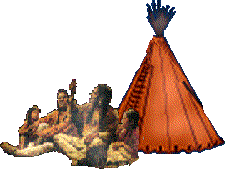
|
- TstsEhstAhese
(HEVAHETANEO'O)
-
-
- "Cheyenne
History"
-
 
-
In quiet
reverence before the lodge fires, the old people of the Cheyenne recounted for their
young, their sacred stories, the deeds of tribal culture, heroes, and their tales of
origin. Without written literature, the Cheyenne, like others, orally passed their
customs, religious ceremonies, and traditions from generation to generation.
Nothing in the Cheyenne legends recalls migration to the North American Continent. It was
believed that the first Cheyenne lived under-ground and were led to the surface by one of
their more adventuresome people, who, following a small source of light, discovered the
world above them.
It is commonly accepted that the Cheyenne were originally from North of the Missouri River
on a large lake. They occupied a region populated by the Algonquon speaking people. It is
suspected they began their tribal migrations from the shores of the Great Lakes or the
upper Mississippi River area. They originally appear in historical records on a map
attributed to Joliet and drawn about 1673.
More definite is a visit of a group of Indians, named "Chaa" or Cheyenne to
LaSalle while he was building Fort Crevecoeur on the Illinois in February, 1680.
By the end of the 1700's the Cheyenne had migrated to the Sheyenne River in eastern North
Dakota. When or why the Cheyenne moved farther up the Minnesota River and ultimately to
the Sheyenne River is unknown, probably due to pressures from the Sioux or Assiniboin.
They lived more than a half century on the Sheyenne.
Their principle village, containing about 70 lodges
was located on the south bank of an old channel of the river, about 12 miles south of
Lisbon, Ransom County, North Dakota. While there they acquired horses and metal knives,
but still did not have guns. Armed with the bow and arrow and lance, the Cheyenne soon
came to depend on the vast buffalo herds to supplement their diet of beans, corn and
squash.
It is estimated they acquired horses about 1750. By the early 1800's, the Cheyenne ranged
widely to the southwest of the Missouri River. A french trader, Persine duLuc, noted that,
although the Cheyenne wandered the greatest part of the year, they sowed
maize (corn) and
tobacco near their "cottages" which they came to reap at the beginning of autumn
(the Cheyenne built earth lodges to live in, some more than 40' in diameter).
When the Lewis and Clark Expedition came upon the Cheyenne along the Missouri River about
1804, their numbers were estimated at about 300-400 fighting men, but Clark did not come
in contact with the whole tribe, which meant the tribe numbered between 1400 and 1600
persons. He described the Cheyenne as "rich in horses and dogs, the dogs carry a
great deal of their light baggage. They confess to be at war with no nation, except the
Sioux, against whom they had been fighting defensive wars for as long as they could
remember."
Once the Cheyenne were on the plains, rapid cultural changes took place. After only two
generations, Cheyenne living in 1804-1806 near present day Scott's Bluff, NE, on the North
Platte River had completely adjusted to the new environment.
Military Societies of the Cheyenne not only had ceremonial functions such as their
participation in the Sun Dance, but also were largely responsible for protecting the
tribes and maintaining tribal discipline. These societies were organized on either
age-grade basis or continuous membership in a specific society.
These Cheyenne Societies were Wolf Soldiers, Fox soldiers, Dog Soldiers and Red Shields or
Bull Soldiers, and later, the Thunder Bows also known as the Bowstrings.
Cheyenne life on the plains early in the 19th century was well adapted to tribal
existence. Their institutions were both meaningful and intergrated. They had worked out a
practical government system and a religion or super-naturalism related directly to the
environment in which they lived, established a satisfying economy, maintained an orderly
family and kinship system, and made alliances with powerful and friendly tribes which
assured that they would not be exterminated by their native foes.
Rivalries developed between bands as their numbers rose and fell. Antagonism between band
members and chiefs finally led to the tribe dividing into the Northern and Southern
divisions, seemingly by individual choice.
The Cheyenne removal to the Arkansas River did not bring peace to the tribe. The early and
mid 1830's were a time of widespread inter-tribal wars on the southern and central plains,
in which the Cheyenne frequently participated. About this time frame the Cheyenne and
Arapaho formed an alliance. The Cheyenne had large horse herds and animosity grew between
the Cheyenne and Pawnee over the years.
There was no cessation of hostilities between the 2 tribes during the 1850's. In 1851-52,
Alights on the Cloud, a prominent Cheyenne chief was killed by the Pawnee. The Cheyenne
gathered their allies, the Arapaho, Brule' Sioux and smaller numbers of Kiowa,
Kiowa-Apache, and Crow and followed their sacred Medicine Arrows and Buffalo Hat into
battle against the Pawnee. The 1853 war against the Pawnee ended in disaster for the
Cheyenne. The warriors of the combined tribes could not drive the enemy from a strong
defensive position and the battle raged indecisivly for hours. Then a body of horsemen
appeared, Pottowatomi, armed with new rifles, who alternately advanced by platoons, firing
and retreating. The Plains Indians were no match for the well organized Pottawatomi
warriors, so the former fled the battlefield. In 1854, however, the Cheyenne revenged
their defeat when they and the Kiowa cut off 113 Pawnee and killed them almost to the man.
Restlessness continued with the tribes and by the winter of 1863-64, Gov. Evans of
Colorado Territory was convinced Indian hostilities would begin in the spring. If all went
well, the Indians could be defeated and Colorado Territory could be cleared of
hostilities. In March of 1864, Major General Samuel R. Curtiss withdrew every man who
could be spared from the Indian frontier to meet a Confederate force poised on the
Arkansas River. Governor Evans began to worry about the defenseless position of the
settlements in Colorado Territory.
End Of Freedom
In 1875, an
Expedition led by Col. Miles from Camp Supply led to the surrender of a majority of the
hostile Cheyenne. The days of freedom ended, the buffalo hunt, the thrill of horse raids,
were all in the past. The Southern Cheyenne were powerless to contest the superior force
of the white man, who gave them rations, schools, Christianity, and its substitutes.
Stripped of their reservation several decades later by land hungry American farmers and
speculators, the Cheyenne declined as disease, despair and lethargy took their toll.
The Southern Cheyenne clung stubbornly to their institutions until, finally in the 1930's,
some recognition of their culture was granted by the United States of America. The
Cheyenne is one tribe with two reservations, one in Oklahoma, the Southern Cheyenne and
one in Montana, the Northern Cheyenne.
The above information was taken from the book, "The Southern Cheyenne", by
Donald J. Buthering, University of Oklahoma Press, Norman, OK.
-
-
-
©Eagles Aerie
Mentor
-Editor : Wareagle
- Original artwork remains the
copyrighted property of
their respective artists.
- Many thanks to
Denton Lund
For permission to use your wonderful graphics
-
2000-2008
-
|
|
|
| | | | |